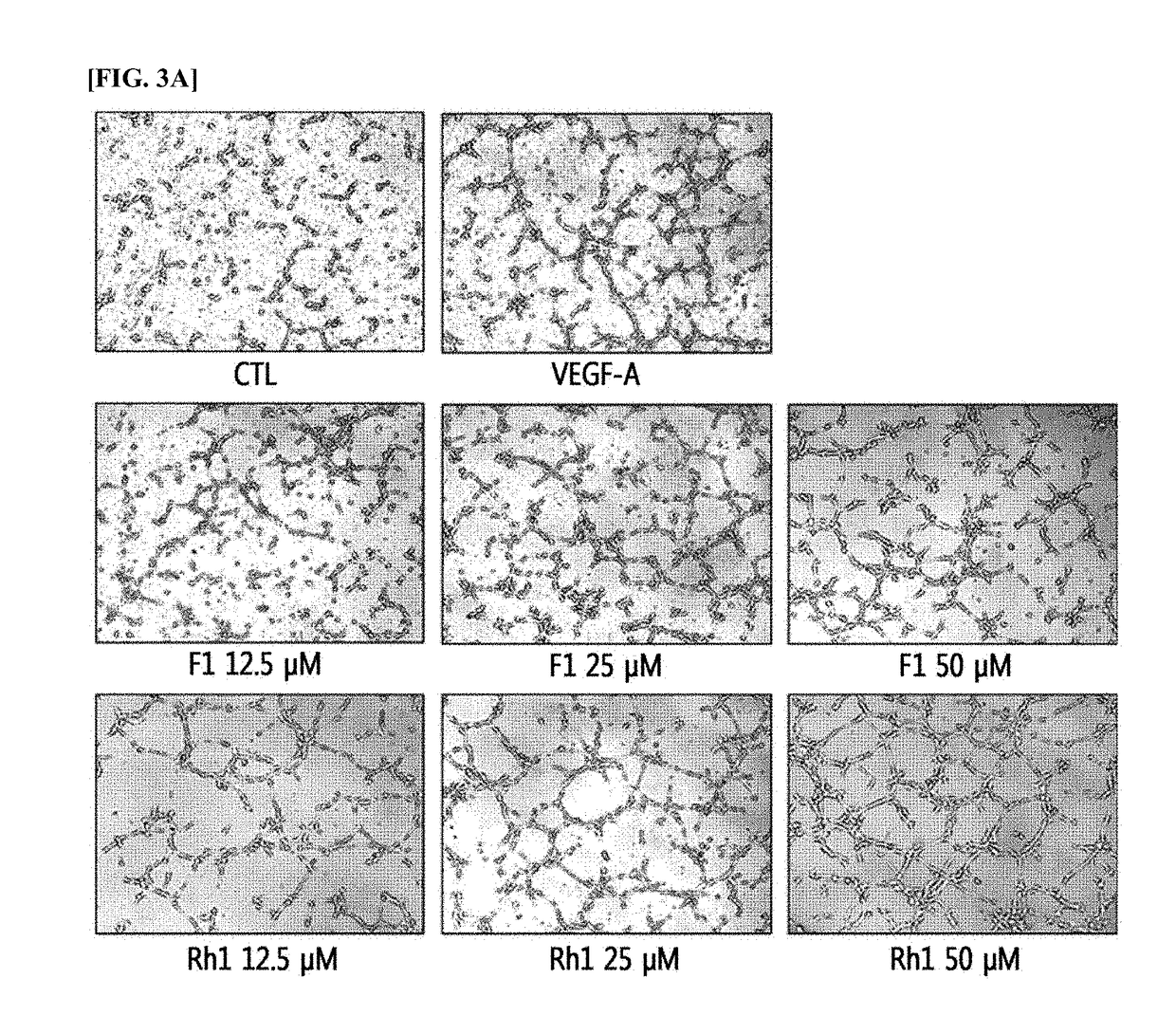Composition for preventing or treating vascular leak syndrome
a vascular leak syndrome and composition technology, applied in drug compositions, plant/algae/fungi/lichens ingredients, extracellular fluid disorders, etc., can solve the problems of loss of vascular function, functional loss of blood vessels, and inhibition of blood vessels related to blood vessels, so as to suppress vascular leakage, prevent or treat vascular leak syndrome, and promote angiogenesis
- Summary
- Abstract
- Description
- Claims
- Application Information
AI Technical Summary
Benefits of technology
Problems solved by technology
Method used
Image
Examples
example 1
Selection of Ginsenosides Exhibiting Angiogenesis-Promoting Activities
[0055]The angiogenesis-promoting activities between human umbilical vascular endothelial cells (HUVECs) and human retinal microvascular endothelial cells (HRMECs) using 10 kinds of ginsenoside compounds (CK, Rh2, Rg3, Rb1, F2, Rd, Re, Rg1, Rh1, or F1). That is, HUVECs or HRMECs were cultured in an incubator (5% CO2 and 37° C.) using 2% FBS, EGM-2 (Lonza, Walkersville, Md., USA) medium. A 96-well plate was coated with Matrigel (BD Biosciences) for 1 hour. Then, HUVECs or HRMECs (104 cells / well, respectively), which were mixed with a 0.1% FBS-containing EBM-2 medium respectively treated with 25 μM of ginsenoside compounds (CK, Rh2, Rg3, Rb1, F2, Rd, Re, Rg1, Rh1, or F1), were seeded on the 96-well plate. After 4 hours of incubation, a tube formation assay was performed and the number of tubes formed was compared by microscopic observation and photographing (FIGS. 1a, 1b, 2a, and 2b). In particular, the cells culture...
example 2
Angiogenesis-Promoting Effect According to Ginsenoside Treatment at Various Concentrations
[0060]The HUVECs or HRMECs, which were cultured by the method of Example 1, were cultured after treating at various concentrations (12.5, 25, or 50 μM) of ginsenoside F1 or Rh1 selected from Example 1 for 4 hours, and the number of tubes formed was compared by performing a tube formation assay (FIGS. 3 and 4). In particular, the cells cultured after treating with DMSO instead of ginsenoside were used as a negative control and the cells cultured after treating with VEGF-A, which is known to promote angiogenesis, were used as a positive control.
[0061]FIG. 3A shows the images of HUVECs cultured by treating with 2 kinds of ginsenosides at various concentrations, and FIG. 3B shows the graph illustrating the comparison results with regard to the number of tubes formed in the HUVECs cultured by treating with the 2 kinds of ginsenosides at various concentrations. As can be seen in FIG. 3, it was confir...
example 3
Cell Proliferation-Promoting Effect According to Ginsenoside Treatment at Various Concentrations
[0063]The HUVECs or HRMECs, which were cultured by the method of Example 1, were cultured after treating at various concentrations (0, 3.125, 6.25, 12.5, or 25 μM) of three kinds of ginsenosides (F1, Rh1, or Rg1), which were confirmed to promote tube formation in Example 1, for 48 hours, and the level of cell proliferation was compared by performing the MTT assay with respect to the cultured cells (FIGS. 5 and 6). In particular, the cells cultured after treating with DMSO instead of ginsenoside were used as a negative control, and the cells cultured after treating with VEGF-A, which is known to promote angiogenesis, were used as a positive control.
[0064]FIG. 5 shows the graph illustrating the comparison results with regard to the proliferation level of HUVECs cultured by treating with 3 kinds of ginsenosides at various concentrations (0, 3.125, 6.25, 12.5, or 25 μM). As can be seen in FIG...
PUM
 Login to View More
Login to View More Abstract
Description
Claims
Application Information
 Login to View More
Login to View More - R&D
- Intellectual Property
- Life Sciences
- Materials
- Tech Scout
- Unparalleled Data Quality
- Higher Quality Content
- 60% Fewer Hallucinations
Browse by: Latest US Patents, China's latest patents, Technical Efficacy Thesaurus, Application Domain, Technology Topic, Popular Technical Reports.
© 2025 PatSnap. All rights reserved.Legal|Privacy policy|Modern Slavery Act Transparency Statement|Sitemap|About US| Contact US: help@patsnap.com



